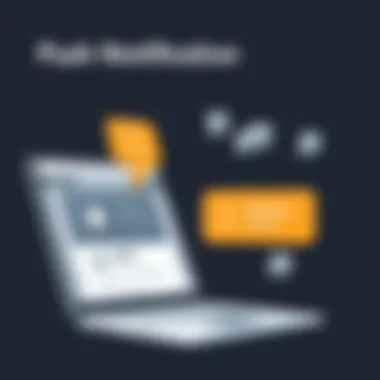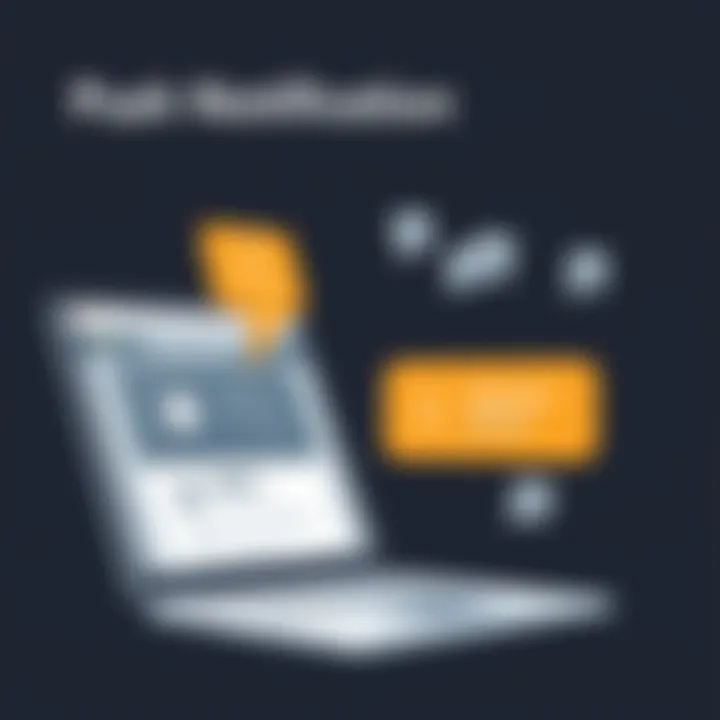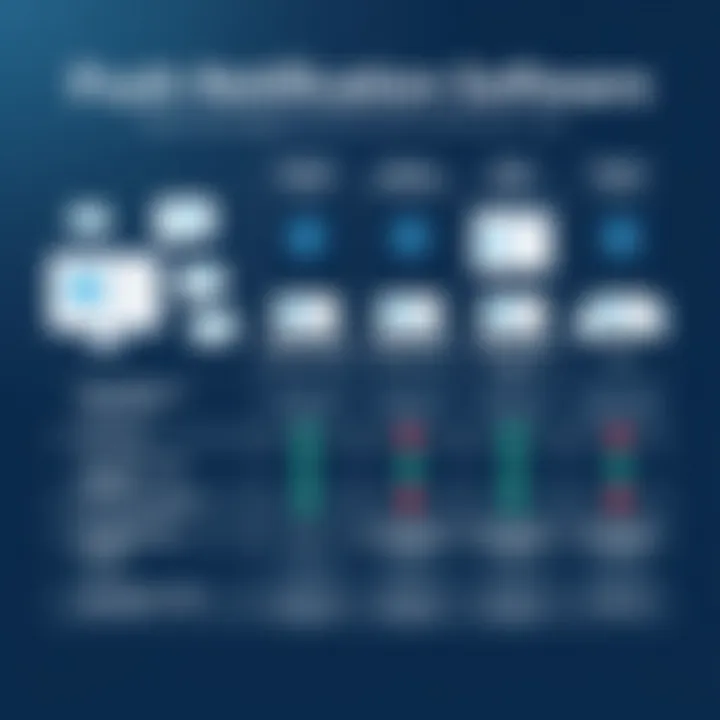Maximizing Engagement with Top Push Notification Tools


Intro
In today’s fast-paced digital landscape, customer engagement is more crucial than ever for small to medium-sized businesses. Push notifications, often seen as mere reminders or alerts, pack a powerful punch when used effectively. They can boost user retention, drive sales, and enhance overall customer satisfaction. However, to harness the full potential of push notifications, businesses need the right tools at their disposal. This article dissects the best push notification software in the market, exploring their features, pricing, and real user experiences.
Purpose of the Software
Push notification software serves a specific and pivotal role for businesses aiming to maintain a connection with their audience. Essentially, it allows companies to send timely messages directly to users’ devices. This direct communication channel is beneficial for informing customers about new product launches, offering special promotions, or even sending reminders about their abandoned carts.
By implementing push notifications, businesses can significantly enhance engagement metrics, ultimately leading to improved customer loyalty.
Key Features
When evaluating push notification software, several key features should be front of mind:
- Segmentation: Allows targeting specific user groups based on behavior or preferences.
- Personalization: Crafting unique messages that resonate with individual users can drastically improve response rates.
- A/B Testing: Testing different messages helps determine what works best for the audience.
- Analytics: Comprehensive analytics enable businesses to track the performance of their notifications, offering insights into areas for improvement.
- Integration capabilities: A good software should pair well with existing platforms and tools, ensuring a smooth workflow.
The right software not only streamlines the process but also empowers businesses to craft more effective engagement strategies, ultimately allowing them to keep their audience in the loop without overwhelming them.
Comparison with Competitors
As with any technological tool, understanding how various options stack up against each other is vital. This comparison can prove invaluable for businesses evaluating which software best aligns with their unique needs.
Feature-by-Feature Analysis
To better understand the unique offerings of different push notification software, let’s analyze some top contenders:
- OneSignal: Known for its robust segmentation and deep analytics, ideal for companies focused on detailed user insights.
- Airship: Great for personalization and has advanced automation features, suitable for enterprises requiring complex workflows.
- PushEngage: User-friendly interface with excellent A/B testing options that cater well to smaller businesses looking to engage without fuss.
Each platform possesses its strengths and weaknesses, which should align with the specific goals of a business.
Pricing Comparison
The financial implications of adopting a push notification system are equally important. Pricing can vary widely, so it’s essential to examine what each software offers relative to cost.
- OneSignal: This platform provides a free tier with essential features, making it accessible for startups or small businesses. Paid plans offer advanced features starting from competitive rates.
- Airship: More geared toward larger enterprises, hence the pricing may be higher, but it reflects its comprehensive offerings.
- PushEngage: Also begins with a free plan, making it appealing for smaller firms, with paid plans that scale as a business grows.
"The best push notification software is one that adapts to the needs of the business while empowering it to maximize customer engagement."
By understanding software offerings, features, and pricing, businesses can better strategize their approach to notifications, ensuring they engage their audience effectively and efficiently.
Preface to Push Notification Software
In a competitive digital landscape, reaching your audience effectively can feel like hunting for a needle in a haystack. As businesses strive to forge stronger connections with users, push notification software has become a vital ally. This technology serves as a direct line of communication to users, delivering timely alerts that can enhance engagement and retention. The importance of leveraging such tools cannot be overstated, especially for small to medium-sized businesses looking to maintain relevance in their niche.
Push notifications provide a swift means to inform users about updates, offers, or new content, keeping the brand at the forefront of their minds. By understanding how push notifications work and their strategic value, businesses can capitalize on this medium to foster loyalty and drive user interaction. It's not merely about sending messages; it's about crafting experiences that resonate with users, reminding them why they chose your service or product in the first place.
Understanding Push Notifications
To fully appreciate the capabilities of push notification software, we must first grasp what push notifications are. Essentially, these are short messages sent directly to a user’s device—be it a smartphone, tablet, or desktop. They serve as alerts for app activity, reminders of upcoming events, or promotional messages. Unlike emails, which may get buried in a crowded inbox, push notifications are designed to grab attention immediately.
With a well-timed notification, businesses can influence customer behavior in real-time. Here’s a concise breakdown of push notifications:
- Instant Delivery: Messages reach users almost instantly, making them perfect for time-sensitive information.
- High Visibility: Notifications typically appear on a user’s lock screen or desktop, ensuring they don’t go unnoticed.
- User Engagement: When utilized effectively, they can boost engagement rates, encouraging users to return to an app or website.
In essence, understanding the core function of push notifications prepares businesses to use them wisely, considering what to send and when to send it, thereby creating a seamless customer experience.
The Role of Push Notifications in Business
Push notifications play a pivotal role in contemporary business strategies by driving communication and engagement. They help businesses maintain a constant presence in the user's daily routine without overwhelming them with unnecessary information. When crafted thoughtfully, these notifications can lead to enhanced user experience and satisfaction.
Moreover, push notifications open a dialog between the brand and the users, allowing businesses to:
- Promote New Features: Letting users know about updates or enhancements can boost usage of existing tools.
- Facilitate User Engagement: Relevant notifications can pique interest, encouraging users to act—a simple reminder about an abandoned cart can turn into a completed sale.
- Deliver Personalized Content: Tailoring notifications based on user behavior not only increases relevance but also enhances customer satisfaction.
"Effective push notification strategies can lead businesses to a gold mine of engagement opportunities, propelling them to success in the digital age."
As you can see, the strategic implementation of push notifications is not merely beneficial; it is increasingly essential in today’s data-driven environment. Businesses that master the art of sending the right message to the right person at the right time stand to gain significant advantages, particularly in retaining users and bolstering brand loyalty.
Criteria for Evaluating Push Notification Software
Evaluating push notification software requires a careful examination of various factors that can significantly impact a business's ability to engage with its audience. Each software has its unique capabilities, and understanding these criteria is essential for businesses seeking to maximize their push notification strategies. In this section, we will delve into critical elements that need consideration when assessing push notification tools, shedding light on their benefits and how they contribute to a successful engagement strategy.
Usability and User Interface


When choosing push notification software, usability is often the first hurdle that buyers encounter. A user-friendly interface allows marketers and business owners to navigate the system with ease. Intuitive design, clear instructions, and straightforward functionalities can make a vast difference, especially for small to medium-sized businesses with limited technical expertise. Imagine trying to launch a campaign only to find yourself lost in a labyrinth of complicated menus and options. That would surely dampen the enthusiasm for using push notifications at all.
- Simplicity in Design: A clean and logical interface is vital. It reduces the learning curve and lets users focus on crafting their messages rather than struggling with software mechanics.
- Accessibility: Accessing push notifications from mobile and desktop devices broadens user engagement strategies, enabling timely interactions.
Overall, an effective push notification platform streamlines the process of creating, scheduling, and analyzing messages to improve customer interaction.
Customization Options
Customization is another cornerstone of beneficial push notification software. In an era where consumers are deluged with messages, generic notifications often fall flat. Tailored messaging can significantly improve engagement rates. Here’s what to keep in mind:
- Message Personalization: Some software allows users to dynamically insert features such as the recipient's name or location. A seemingly small touch that can have considerable effects on open rates.
- Template Variety: Offering a range of templates can help businesses maintain their branding while saving time on design work.
A rich set of customization options enables businesses to engage their audience distinctly, messaging that feels personal rather than an afterthought.
Integration Capabilities
Many businesses leverage several tools to manage their operations effectively. This makes integration capabilities paramount. Ideally, the selected push notification software should easily integrate with existing platforms. Consider the following aspects:
- Compatibility with CRM and Marketing Tools: Integration with systems like HubSpot or Salesforce can be a game changer, allowing seamless data sharing and enhancing targeting accuracy.
- API Availability: An accessible API can allow for custom integrations tailored to specific business needs, fostering unique engagement strategies.
When a push notification system fits effortlessly within a tech stack, it enhances workflow efficiency and usability.
Analytics and Performance Metrics
To truly understand the impact of push notifications, analytics and performance metrics are crucial. Without the proper tracking tools, businesses can easily miss opportunities to enhance their engagement strategy. Here’s why this area matters:
- Real-Time Data: An ideal system provides real-time feedback on notification delivery, engagement rates, and user interactions. This immediate insight can guide future messaging strategies effectively.
- A/B Testing Capabilities: The ability to test different messages or timing can help determine optimal engagement strategies, ensuring that efforts yield the best returns.
Being able to analyze and tweak strategies based on performance data is vital for optimizing push notification effectiveness.
Support and Customer Service
Lastly, as with any technology, robust customer support can’t be overstated. Even the most intuitive software may have hiccups along the way, and timely support can make all the difference. Factors to consider include:
- Availability of Resources: Comprehensive FAQs, tutorials, or live chat support can drastically improve users' experiences and decrease frustration.
- Response Times: Quick response to queries can prevent outages or stalled campaigns, ensuring consistent engagement with the audience.
Reliable support can transform what could be a frustrating experience into an efficient one, encouraging users to leverage the software fully.
Top Push Notification Software Tools
Understanding the landscape of push notification software is crucial for businesses aiming to amplify customer engagement. Selecting the right tools can make a world of difference in how effectively a company communicates with its users. The right push notification software offers more than just the ability to send messages; it can enhance user experience, optimize engagement strategies, and ultimately contribute to a healthier bottom line. Factors such as usability, integration capabilities, and support services play a pivotal role in determining how well a chosen tool fits into a company's operational framework.
Firebase Cloud Messaging
Firebase Cloud Messaging is a heavyweight in the realm of push notifications. Developed by Google, it provides a robust infrastructure that can handle notifications across various platforms.
Key Features
The standout characteristic of Firebase Cloud Messaging includes its seamless integration capabilities with other Firebase products. This makes it a go-to choice for businesses that already harness Firebase for app development. Notably, its ability to send messages, both upstream and downstream, allows for dynamic communication. However, some may find the complexity of implementation a hurdle, especially if they are newcomers to the Firebase suite.
Use Cases
Firebase Cloud Messaging shines in mobile application scenarios, especially for e-commerce and social networking apps. Businesses can utilize it to deliver real-time updates, promotional messages, or even chat notifications. Its distinctive ability to target notifications based on user engagement data can significantly enhance user retention rates. Still, users must consider that leveraging these advanced features might require a learning curve, which may not suit every team's capabilities.
Pricing Structure
Firebase Cloud Messaging is beloved for its zero-cost pricing tier for basic features, making it a popular choice among startups and small businesses. Companies can utilize fundamental capabilities without a penny spent. Nonetheless, as your needs grow more advanced, you might have to explore the paid tiers of the Firebase ecosystem, which can become pricey when adding other features.
OneSignal
OneSignal has carved out a strong niche in the push notification market. It is known for its user-friendly interface and extensive customization options.
Key Features
OneSignal’s key feature is its powerful segmentation capabilities. This allows businesses to send targeted notifications based on user behavior and demographics. This ability to tailor messages significantly increases engagement rates. However, although user-friendly, advanced configuration might still baffle less tech-savvy users.
Use Cases
OneSignal is often favored by content-driven sites and media outlets looking to keep followers engaged. Its capability for A/B testing notifications helps businesses fine-tune their approach and maximize engagement. Still, users should be wary of data privacy considerations as OneSignal collects user data to provide those insights.
Pricing Structure
OneSignal operates a freemium model, allowing small businesses to start without immediate costs. However, as a business's audience grows and engagement needs diversify, the pricing can escalate based on the number of users and the advanced features required. This flexibility can be an asset but also means keeping an eye on potential costs as utilization deepens.
Pushwoosh


Pushwoosh is another contender that specializes in personalized marketing through push notifications.
Key Features
The uniqueness of Pushwoosh lies in its multi-channel marketing approach, which merges web, mobile, email, and more, making it versatile for marketers. A simple user interface complements a robust set of features, allowing for easy campaign creation. Despite its advantages, some users might miss in-depth analytics tools that offer better insights into message impact.
Use Cases
Pushwoosh is particularly beneficial for brands looking to create omni-channel campaigns. This could range from loyalty programs to targeted promotions across different platforms. The software’s integration potential also makes it a strong choice for businesses looking at a holistic approach to user engagement. Nevertheless, businesses may require additional tools for more detailed analytics.
Pricing Structure
Pushwoosh offers a tiered pricing model, making it accessible for startups but potentially costly for larger enterprises. The tier structure allows businesses to choose a plan according to their size and needs, ensuring they are not overpaying for unused features. Still, depending on the level of services chosen, costs can add up quickly.
Airship
Airship stands out due to its comprehensive capabilities aimed at enhancing customer journeys through personalized messaging.
Key Features
Airship’s strength lies in its automation and personalization features. The platform allows businesses to set up automated workflows that trigger notifications based on user behavior. This level of targeting can be exceptional for enhancing customer journeys. However, setting up such intricate systems may require initial effort and expertise that can deter smaller businesses.
Use Cases
Airship is especially powerful for businesses that invest heavily in brand engagement and customer loyalty programs. They can use it to reach out during special events, anniversaries, or personalized milestone reminders. But, navigating its more advanced features can be complex for beginners.
Pricing Structure
Airship has a reputation for premium pricing compared to its competitors. While it offers powerful tools, businesses need to assess carefully whether the investment aligns with their engagement goals. The return on investment can be significant, provided a business is poised to fully leverage its capabilities.
Pusher
Pusher is mainly recognized for real-time functionalities but it also extends into the push notification realm effectively.
Key Features
The most compelling feature of Pusher is its real-time capabilities. It allows for instant updates and notifications, making it a smart choice for apps that require immediacy, like chat applications or live notifications. Nonetheless, users should be prepared to handle potential scalability limits as their user base grows.
Use Cases
Pusher fits exceptionally well into sports apps, or real-time data services where timely information is crucial. It can keep users clued-in without any significant lag in message delivery. Still, its core focus on real-time applications means businesses relying on less immediate communication may find it lacking.
Pricing Structure
Pusher offers a flexible pricing model based on usage, making it appealing for developers and businesses that scale. Starting from a free tier, costs ramp up with usage. This can be advantageous in avoiding upfront investments but could lead to higher bills with increased use, especially in high-demand applications.
Comparative Analysis of Push Notification Software
In the crowded digital landscape, making sense of the multitude of push notification software options can feel a bit like trying to find a needle in a haystack. A thorough comparative analysis delivers clarity, allowing businesses to determine the best tools tailored to their unique requirements. This section underscores the significance of comparing feature sets, pricing, and user experiences, emphasizing how these factors influence decision-making. By dissecting the elements that matter most, organizations will extract maximum value from their choice of software.
Feature Comparison Matrix
A feature comparison matrix stands as an indispensable tool for evaluating different push notification software. This matrix allows users to sift through various functionalities side-by-side, highlighting essential aspects such as ease of use, customization possibilities, and integration capabilities. For instance, software like Firebase Cloud Messaging may shine with its seamless integration into existing applications, while OneSignal might excel in user-friendly interfaces.
Key features often evaluated include:
- Segmentation Ability: How detailed can user segments be?
- Notification Scheduling: Is there a feature to schedule messages at optimal times?
- A/B Testing: Can businesses test which messages perform better?
- Visualization Tools: Are there analytics to evaluate how messages are received?
Creating a matrix that details these features helps in narrowing down choices and can make the decision process more efficient.
Pricing Comparison
When it comes to selecting the right push notification software, pricing isn't background noise; it's often the bottom line that shapes choices. Pricing structures vary widely across platforms, encompassing everything from freemium options to hefty monthly subscriptions. A thorough comparison here reveals not only the cost but also what businesses get for their investment.
For example, some systems offer tiered pricing: the more contacts you have, the more you pay. Smaller businesses might initially lean toward cost-effective solutions like Pusher which provides a more basic set of features at a lower price, while larger enterprises might find the more robust offerings of Airship preferable, despite the higher costs.
Methods of evaluating pricing:
- Monthly/Annual Subscriptions: Is there a discount for annual payments?
- Cost per Notification: Are businesses charged by the message or by the number of users?
- Free Trials: Does the platform allow testing before committing?
Detailed pricing comparisons empower businesses to match their budgets with the features they prioritize.
User Reviews and Feedback
User reviews provide invaluable insights into the real-world application of different push notification software. While marketing materials may boast about capabilities, firsthand experiences can reveal critical nuances. Seeking out reviews on platforms like Reddit or in specialized IT forums can expose both strengths and weaknesses, informing prospective users.


Key aspects to focus on might include:
- Reliability: Are notifications consistently delivered on time?
- Support Services: How responsive is customer support? Users often speak up when they face issues with customer assistance.
- User Experience: How intuitive is the platform? Complicated software can hinder rather than help, causing frustration.
"The right choice hinges on more than just features; it's about the experiences of those who’ve walked the path before you."
Gathering various viewpoints can lead to a well-rounded understanding of which systems excel and which ones may fall short, making user feedback an essential pillar in this comparative analysis process.
Best Practices for Using Push Notifications
Push notifications serve as a powerful instrument for engaging users and retaining customers. When employed correctly, they can elevate the interaction between a business and its users. Understanding the best practices for using push notifications is crucial in ensuring that the notifications don’t just become digital noise but instead contribute to building a stronger relationship with users. This section is dedicated to exploring these best practices that can maximize engagement while avoiding potential pitfalls.
Crafting Engaging Messages
The crux of effective push notifications lies in crafting engaging messages. An effective notification doesn’t just catch the eye; it must also resonate with the user’s current needs and preferences. Here are some pointers to consider:
- Clarity is Key: Your message should be clear and to the point. Avoid jargon that may confuse the user. For instance, instead of saying "Enhance your experience with our upgraded features!", use a more straightforward approach like "Check out our new features today!"
- Personalization: Adding a personal touch can drastically improve engagement. Use the user’s name or tailor messages based on their past behavior. "Hi John, your favorite book is on sale!" is much more inviting than a generic message.
- Value Proposition: Clearly articulate the benefit of engaging with the notification. If a user sees "Don’t miss out on 20% off on your next purchase!", they have a compelling reason to check it out.
- Urge Action: Including a call to action (CTA) can also enhance the effectiveness of a notification. Phrases like "Shop Now" or "Learn More" can encourage immediate engagement.
Overall, the goal is to connect with the user in a meaningful way that prompts them to act.
Frequency and Timing of Notifications
Timing and frequency are often overlooked aspects that play a significant role in the success of push notifications. Getting the timing right can be the difference between engagement and annoyance. Here are considerations for optimizing frequency and timing:
- Know Your Audience: Understanding when your audience is most active is essential. Analyze user data to find peak engagement times. For example, a retail app might find users more responsive during evenings or weekends.
- Avoid Overload: Striking a balance in frequency is crucial. Bombarding users with notifications can lead them to disable alerts or uninstall the app. A thoughtful approach might be to limit messages to one or two a week, ensuring that each one is meaningful.
- Test Different Times: Experiment with sending notifications at varying times and days to see what resonates best. A/B testing can help identify patterns in user behavior and preferences.
- Consider Time Zones: If your user base is spread across different time zones, be mindful of when you send notifications. You wouldn’t want a notification meant for a local audience to reach someone in another time zone at an odd hour.
Future Trends in Push Notification Technology
The realm of push notifications is rapidly evolving, carving out a significant space in the marketing toolkit for businesses of all sizes. As customer engagement becomes ever more crucial, understanding future trends can help organizations stay ahead of the curve, not to mention how these trends can influence consumer behavior and loyalty. By anticipating the direction of push notification technology, businesses can optimize their communication strategies with users and enhance their engagement metrics. This section dives into the growing importance of personalization and AI integration, alongside the shift towards cross-platform notifications, reshaping how businesses connect with consumers.
Personalization and AI Integration
Customized communication is often regarded as the holy grail of marketing, and push notifications are no exception. The integration of artificial intelligence allows for a deeper understanding of customer preferences and behaviors. By analyzing historical data, businesses can tailor notifications to fit individual user profiles. For instance, a retail app can send tailored offers based on recent purchases, browsing history, or even demographic information. This targeted approach can significantly increase the likelihood of user interaction, making customers feel valued rather than feeling just like another number.
Personalization is more than just using a name in a message; it's about understanding and anticipating user needs.
Consider a coffee shop app that tracks a customer’s favorite drinks. When that user passes by the shop on a chilly morning, the app can send a timely notification offering their go-to hot beverage at a discount. Such relevant messaging can foster a sense of connection and can turn a casual customer into a regular patron.
With the growth of machine learning, the ability of software to adapt and predict user behavior continues to improve. This includes learning from previous notification responses, which makes notifications timely and contextually aware. Not only does this enhance user experience, but it can also significantly improve conversion rates.
Benefits of Personalization:
- Higher engagement rates due to relevant content.
- Increased customer satisfaction as users receive exactly what they want.
- Greater return on investment (ROI) from targeted marketing campaigns.
However, businesses must tread carefully. Too much personalization can come off as intrusive, leading to negative user experiences. Balance is key, ensuring customers don’t feel overwhelmed by overly personalized messaging.
Cross-Platform Notifications
In our interconnected world, users frequently switch between devices—from smartphones to tablets, and even desktops. This trend necessitates a cross-platform approach for push notifications. Businesses must ensure that users have a seamless experience whether they are checking their messages on an app, desktop, or a web browser.
By creating notifications that appear consistently across all platforms, businesses can maintain engagement no matter where their users are interacting. For instance, a user could receive a shopping cart reminder on their phone and a follow-up email on their desktop, reinforcing the message regardless of the device they choose.
Cross-platform notifications can improve user retention significantly, as people are less likely to overlook critical updates when they come through multiple channels in a tailored manner. It also paves the way for a more cohesive customer journey, reducing friction points that often lead to lost opportunities for interaction.
Considerations for Cross-Platform Notifications:
- Consistency is key: Ensure the tone and branding remain the same across all devices.
- Understanding user preferences: Some users may prefer notifications on certain platforms over others—respecting their preferences can help reduce annoyance.
- Timing matters: Different platforms might have different optimal times for notification delivery; understanding user behavior on each platform enhances effectiveness.
The End and Recommendations
The significance of a well-thought-out conclusion in any article cannot be overstated. In our exploration of push notification software, the conclusions drawn here are paramount, as they synthesize crucial insights gathered through detailed analysis. Ultimately, businesses today operate in a highly competitive landscape where effective engagement strategies can make all the difference.
This section aims to distill essential findings while offering actionable recommendations for small to medium-sized businesses, entrepreneurs, and IT professionals. The right push notification software not only propels customer engagement but also fortifies user retention. Ignoring these tools is akin to sailing a ship without a compass—you may drift aimlessly!
Summary of Findings
Throughout this article, we've highlighted various aspects of push notification software that are vital for fostering customer relationships. Here are the key takeaways:
- Efficiency in Communication: Push notifications serve as a direct line of communication between businesses and their customers, ensuring timely updates and personalized offers.
- Diverse Options: The software options available today allow for a wide range of functionality, from basic alerts to complex user engagement strategies.
- Data-Driven Insights: Most tools offer comprehensive analytics to track interaction rates and user behavior, enabling informed decisions.
By amalgamating these insights, businesses can create tailored strategies which cater to their specific audience needs and preferences, setting the stage for lasting customer loyalty.
Final Recommendations for Businesses
When selecting the right push notification software, keeping the following pointers in mind will help steer you toward making a well-informed choice:
- Prioritize Usability: The interface should be intuitive; if it's too complicated, your team may struggle to utilize it effectively.
- Customization is Key: Choose software that allows for tailored messages based on user behavior. Personalized content generally performs better than generic notifications.
- Integration Compatibility: Ensure that the push notification platform can seamlessly integrate with existing systems like CRM software. This will streamline your processes.
- Test and Measure: Implement A/B testing to compare different message styles or sending times. Analyze which generates higher engagement rates.
- Support Services: Reliable customer support can make a world of difference. Opt for a provider that offers solid assistance and resources for troubleshooting.
By adopting these recommendations, businesses can navigate the push notification landscape with greater confidence and success. The efficacy of engagement tactics rests heavily on the choices made today.
"Effective engagement strategies can make or break customer relationships in just a click."



